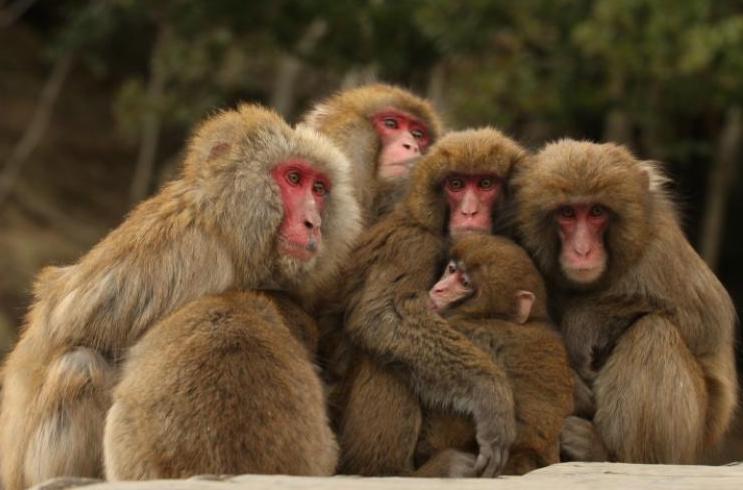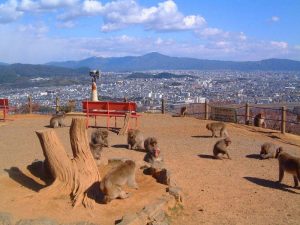
Meet some of my neighbors!
Yes, we have monkeys in Japan, right where I live.
There are an estimated 950 in Hyogo Prefecture — a prefecture is the equivalent of a state and Japan has 47 total — and 180 of the critters in Sasayama, Hyogo, my hometown.
Not that we see them that often. But I have seen them.
Once on a bike ride very close to my house, I spotted one in a farmer’s field, sitting in the midst of rows of beautiful, ripe vegetables, enjoying his own personal buffet. He was very mature, rather large, not a monkey I’d want to mess with.
Speaking of which, my step-daughter got into her car one morning, and a smaller but extremely upset macaque — that’s the variety we have here, pictured above — jumped on her hood, issued all sorts of threatening gestures, screeches, and probably even monkey expletives, about some matter none of us have any clue about. It might have been related to the presence in the house of my step-daughter’s black labrador, as monkeys — at least our local monkeys — are fascinated with domesticated dogs. The incident ended without any damage to her car, the mirrors and windshield wipers still in place, with the monkey bounding off to its next soapbox to lodge complaints about whatever crises monkeys believe warrant their histrionic objections.
It’s not as if we’re not trying to coexist with our furry friends. There’s room for all.
 There’s a park in Kyoto — the Iwayatama monkey park. If you’re ever in that city, I highly recommend it. The park is a short walk across the Oi River from Arashiyama, a must-see district with many interesting temples, shrines, stores, a bamboo forest, the site for a number of wonderful festivals. For about $100, you can get made up head-to-toe as a geisha, something I would love to do, even if it would understandably put my sexuality in serious question among my Western friends. Here in Japan, they’re not so hung up on such matters. There are many celebrities, some of whom regularly appear on television, who are either transvestites or transexuals.
There’s a park in Kyoto — the Iwayatama monkey park. If you’re ever in that city, I highly recommend it. The park is a short walk across the Oi River from Arashiyama, a must-see district with many interesting temples, shrines, stores, a bamboo forest, the site for a number of wonderful festivals. For about $100, you can get made up head-to-toe as a geisha, something I would love to do, even if it would understandably put my sexuality in serious question among my Western friends. Here in Japan, they’re not so hung up on such matters. There are many celebrities, some of whom regularly appear on television, who are either transvestites or transexuals.
 Anyway, getting back to the monkey park. It’s on top of a modest-size mountain. The hike alone is worth it, up a splendid trail through the forest which covers the entire mountain until you reach the summit. On top you’ll find over 200 monkeys, hanging out, looking for food handouts — you can buy appropriate nutritional items from the park station — doing what monkeys on public display typically do. You are cautioned to NEVER look them squarely in the eyes, as they take that as confrontation, a sign that you are threatening and are ready for battle.
Anyway, getting back to the monkey park. It’s on top of a modest-size mountain. The hike alone is worth it, up a splendid trail through the forest which covers the entire mountain until you reach the summit. On top you’ll find over 200 monkeys, hanging out, looking for food handouts — you can buy appropriate nutritional items from the park station — doing what monkeys on public display typically do. You are cautioned to NEVER look them squarely in the eyes, as they take that as confrontation, a sign that you are threatening and are ready for battle.
I’ve taken this advice and extended it to all my human interactions, especially with anyone in the West. I never look them in the eye. If they’re American, they probably are armed to the teeth and that would be the end of John Rachel. No more monkey sightings or even my characteristic monkey business.
Banana anyone?




Life In Japan: Monkeys
Meet some of my neighbors!
Yes, we have monkeys in Japan, right where I live.
There are an estimated 950 in Hyogo Prefecture — a prefecture is the equivalent of a state and Japan has 47 total — and 180 of the critters in Sasayama, Hyogo, my hometown.
Not that we see them that often. But I have seen them.
Once on a bike ride very close to my house, I spotted one in a farmer’s field, sitting in the midst of rows of beautiful, ripe vegetables, enjoying his own personal buffet. He was very mature, rather large, not a monkey I’d want to mess with.
Speaking of which, my step-daughter got into her car one morning, and a smaller but extremely upset macaque — that’s the variety we have here, pictured above — jumped on her hood, issued all sorts of threatening gestures, screeches, and probably even monkey expletives, about some matter none of us have any clue about. It might have been related to the presence in the house of my step-daughter’s black labrador, as monkeys — at least our local monkeys — are fascinated with domesticated dogs. The incident ended without any damage to her car, the mirrors and windshield wipers still in place, with the monkey bounding off to its next soapbox to lodge complaints about whatever crises monkeys believe warrant their histrionic objections.
It’s not as if we’re not trying to coexist with our furry friends. There’s room for all.
I’ve taken this advice and extended it to all my human interactions, especially with anyone in the West. I never look them in the eye. If they’re American, they probably are armed to the teeth and that would be the end of John Rachel. No more monkey sightings or even my characteristic monkey business.
Banana anyone?